| Home > Policy > White Paper, Notice, Announcement > White Paper > JAPAMESE GOVERNMENT POLICIES IN EDUCATION,SCIENCE AND CULTURE 1990 > PART |
||
The existing system of graduate schools, which was introduced under the School Education Law enacted in 1947, has the following two basic characteristics:
Firstly, the present graduate school is independent of any undergraduate faculties in each university. Under the pre-war system, each faculty had its own postgraduate department, and the graduate school of the university was composed of the postgraduate departments of all faculties. Under the post-war system, the graduate school is legally defined as an educational and research unit independent of any faculties.
Secondly, the present graduate school has its own course of
study. The pre-war graduate school was defined as an organ responsible for "pursuing
arts and sciences in depth." and the doctor's degree was to be awarded to those
students who have engaged themselves in academic research and have completed
a dissertation for the doctor's degree. On the other hand, the post-war graduate
school is defined as an organ responsible for "instruction and research regarding
theories and app1ication of sciences." It is also defined as an educational unit
which has its own courses of study and which is independent of any faculties.
An academic degree (doctor's or master's degree) is defined as a certificate
testifying that the holder has completed one of these courses of study.
Graduate schools carry out basic research activities in all academic disciplines, and thus provide a sound basis for the development of scientific research of all categories. They are also responsible for the development of highly qualified researchers and professionals.
Today, in the international community where technological changes and the spread of information media are rapidly going on, it has become an important task for any member country of the community to promote creative basic research of a high standard and to develop excellent people who will contribute to the promotion of such research work. It has become more and more important for Japan to make contributions to the international community by promoting creative basic research and to cope properly with the social demands for the development of highly qualified researchers and professional workers supporting international contributions, as well as for the reeducation of practicing engineers and other professionals.
In 1990 the total number of universities having a graduate school
was 313 of the 508 universities in Japan. Enrollments in graduate schools have
been constantly increasing. The total number of students in these schools was
90,238 in 1990. (See Chart ![]() -2-7 and 8.) As compared with other countries, however,
it can be stated that the scale of graduate schools in Japan is extremely small.
(See Chart
-2-7 and 8.) As compared with other countries, however,
it can be stated that the scale of graduate schools in Japan is extremely small.
(See Chart ![]() -2-9.) The total number of university teachers concerned with instruction
in graduate schools was 51,587 in 1989 for all universities, national, local
public and private.
-2-9.) The total number of university teachers concerned with instruction
in graduate schools was 51,587 in 1989 for all universities, national, local
public and private.


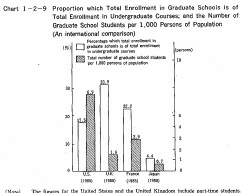
Since the early 1980's the proportion of graduate school student
places filled up has been gradually improving. In 1989 the proportion was 87%
for master's degree courses and 60% for doctor's degree courses. In some courses,
including master's courses in engineering, the number of entrants exceeded the
number of places, while in some other courses, such as doctor's courses in the
field of social science, even the number of applicants was less than the number
of places. (See Table ![]() -2-10.) Within a same field, the proportion of student
places filled up varies greatly among different graduate schools.
-2-10.) Within a same field, the proportion of student
places filled up varies greatly among different graduate schools.
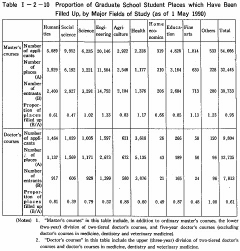
The fact that the total number of graduate school entrants is less than that of student places seems to be attributable to the following background: (l) employers in Japan tend to employ new graduates from undergraduate courses, rather than graduate courses. except for certain fields (2) the role of graduate schools as institutions for training highly qualified professionals has not necessarily been firmly estab1ished and (3) graduate schools have not adequately developed the teaching content or methods adapted to the above role of these schools.
5) Acceptance of foreign students
In recent years fore it students enrolled in postgraduate courses
at Japanese universities have been increasing to a great extent. As of 1 May
1989 the number of these students was 10,568, or 33.8% of all foreign students
enrolled in Japanese universities. (See Table ![]() -2-11.) The largest number of
them (3,231) were enrolled in engineering courses. followed by social science
courses (2,238), humanities courses (1,383) and agricultural courses (1,059).
The proportion of total graduate students who are foreigners is 11%. This percentage
is higher than the proportion of total undergraduate students who are foreigners.
-2-11.) The largest number of
them (3,231) were enrolled in engineering courses. followed by social science
courses (2,238), humanities courses (1,383) and agricultural courses (1,059).
The proportion of total graduate students who are foreigners is 11%. This percentage
is higher than the proportion of total undergraduate students who are foreigners.

A relatively large number of degrees awarded (both master's
and doctor's degrees) are found in scientific fields. (See Table ![]() -2-12.) In
the fields of humanities and social science, it is not so easy for students to
obtain a doctor's degree. This fact involves a serious problem as to awarding
doctor's degrees to foreign students specializing in these fields.
-2-12.) In
the fields of humanities and social science, it is not so easy for students to
obtain a doctor's degree. This fact involves a serious problem as to awarding
doctor's degrees to foreign students specializing in these fields.
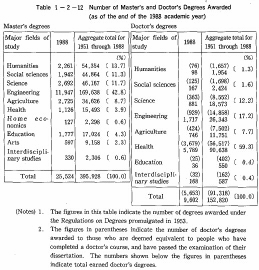
Of the total graduates from master's courses in 1989. 72% were employed and 15% advanced to doctor's courses. Of those who got employment. 56% were employed in manufacturing industries, 22% in service industries, 7% in public services, and 4% in transport and te1e communications.
Of the total graduates from doctor's courses in 1989, 64% got employment and 24% did not become employed. Of those who got employment. 80% were employed in service industries, 12% in manufacturing industries and 4% in public services. Of those who got employed in service industries. 46% were employed in the education sector. As of 1989 there were approximately 1,600 "postdoctoral" students (who are continuing their study at a university with no full-time employment after earning a doctor's degree or completing a doctor's course with no doctor's degree earned). There seem to be diverse reasons for their prolonged stay at university. Some students may be waiting for another opportunity for getting employment while continuing their studies, and some others may be preparing for a dissertation for a doctor's degree. Since 1985 when the number of postdoctoral students reached a peak, the number of these students has been gradually decreasing, due to an increase in industrial firms employing graduates from doctor's courses in the context of the progress of science and technology, and due to an increase in the number of new appointments of university teachers in the context of the enlarged scale of higher education.
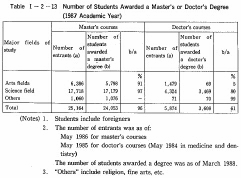
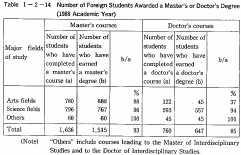
A graduate school is to offer master's and/or doctor's courses.
The statutory aims of these courses were amended twice in 1974 and in 1989. Until
recent years, graduate schools had been functioning primarily as institutions
for the training of university teachers and researchers in a narrow sense. Recently,
however, graduate schools which are active in providing the training of highly
qualified professionals and the reeducation of practicing engineers have been
increasing. In these graduate schools educational and research activities which
are related to practical work in business and industry are carried out. There
are a large number of applicants for admissions to these schools. It is expected
that there will be a growing number of graduate schools of this type and of other
diverse types in the future.
So far, education in graduate schools has been provided mainly through teachers' supervision of students' research work whereby individual teachers give their students supervision and guidance for the preparation of a dissertation for a degree and for other research purposes. It has not been a usual practice that teachers develop a definite curriculum for students. Since the present graduate school was designed to offer definite courses of study; there is a great necessity for developing and enriching systematic curricula with the aim of enabling students to acquire a broad outlook and profound academic knowledge.
Especially, if graduate schools are to admit and educate a wide
range of students with diverse backgrounds, including those students who have
not been given an undergraduate education in the related specialized fields,
those who are working adults and those who are students from overseas, graduate
schools need to adequately consider and examine how to develop appropriate curricula.
In order to enrich the content and methods of educational and research activities in graduate schools. it is desirable that innovative systems. such as a system of credit transfer between different universities and a system whereby a graduate school may entrust another graduate school (or a research institute) to supervise part of the research work of some of its own students, be utilized in suitable manners. These arrangements have been utilized by some graduate departments. Their wider utilization is advisable.
In addition, innovative attempts are necessary also with regard
to students' admission to graduate schools. as well as their completion of a
graduate program, with a view to giving more flexibility to the existing arrangements.
Such attempts may include: flexible arrangements for allowing students to be
admitted to the graduate school allowing students to complete a master's course
without submitting a dissertation; allowing students to complete a master's or
doctor's course in a shorter period of time.
Graduate schools may provide master's courses where instruction is given exclusively in the evening. (Article 2-2 of the Standards for the Establishment of Graduate Schools.) In addition, conventional master's courses may provide students with instruction or with supervision of their research work in the evening, on weekends or at certain other special periods of time. (Article 14 of the same Standards.) In order to cope properly with the diverse needs of working adults and other students, it is important to put into practice these innovative educational approaches.
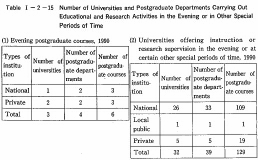
Graduate schools need to improve the level of research expenditure, the adequacy of buildings and equipment and other conditions supporting their educational and research activities, if they are to fully carry out their public functions as centers of excellence which are truly attractive to researchers, high-level professionals and excellent prospective researchers and professionals. For this reason, the Ministry of Education. Science and Culture has been helping provide most advanced equipment for educational and research activities to those national, local public and private graduate schools which have demonstrated outstanding accomplishments in education and research. It is necessary that the Ministry continue to improve and expand relevant infrastructures for graduate schools. In providing these infrastructures, the Ministry needs to give priorities to those graduate schools which have been carrying out active educational and research activities.
f Financial aids to graduate students
In order to secure an adequate number of excellent students
for graduate schools, it is required to increase scholarships and other forms
of financial aid to graduate students. In particular, students enrolled in the
upper division of a doctor's course should be regarded as young researchers and
provided with a relevant economic status. To this end, the Ministry has helped
the government-supported Japan Scholarship Foundation expand its student aid
programs. In 1985 the Ministry introduced special fellowship programs under which
students enro1led in the upper division of a doctor's course, as well as students
who have completed a doctor's course, are given financial assistance suitable
for young researchers. These governmental measures need to be continued and expanded
in the future.
Under the pre-war university system, graduate departments were attached to individual undergraduate faculties. Although under the current system graduate departments are legally separate units independent of undergraduate faculties, existing graduate departments are usually composed of teaching staff at the related undergraduate faculty. Most graduate departments also share the same facilities and equipment with the undergraduate faculty.
If graduate schools are to keep up with the progress of scientific research and with the various changes of society, and thus to properly carry out their educational and research activities in new scientific areas and interdisciplinary areas, it is necessary for them to design for themselves a separate and unique structure quite different from the structure of any undergraduate faculty.
For this reason, in recent years some graduate departments and
courses have been created which are independent of any particular undergraduate
faculties or departments. There are an increasing number of teachers serving
a graduate school on a full-time basis. (See Chart ; ![]() -2-10.) There has been
an increase in the buildings and equipment which are used exclusively by graduate
schools.
-2-10.) There has been
an increase in the buildings and equipment which are used exclusively by graduate
schools.
Further, the amendment in 1976 to the School Education Law made it possible to define as a university an institution offering graduate courses only (in other words, offering no undergraduate courses). A few universities of this new type have been created: the Graduate University for Advanced Studies, Hokuriku Graduate University of Advanced Science and Technology, etc.
In the coming years it will be necessary to increase institutions of this type. And to increase the number of teachers serving postgraduate courses on a full-time basis and secure independent staff structure for graduate schools. Further, more and better facilities and equipment should be provided for their own use.
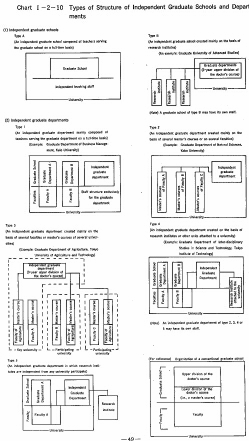
Japan lags behind many other countries with respect to the quantitative development of graduate schools. If Japan is to contribute to the international community through developing creative basic research and to continue to maintain and develop an energetic society, it will be essential to ensure the quantitative expansion of graduate schools and thus to train and recruit highly qualified human resources. It will be also necessary to ensure a balanced development of different fields of graduate studies and to cope with social demands for lifelong learning and for there education of working adults.
On the other hand, in Japan the original aim of graduate schools
offering definite courses of study has not necessarily been fully understood
by university people, and so far graduate schools in this country have been institutions
for the training of research workers in a narrow sense of the words. Therefore,
a fair evaluation of people who have completed a graduate program has not been
established in some sectors of society. Accordingly, in expanding graduate schools
quantitatively in the future, it will be necessary to ascertain social demands
for graduate students in different fields of study. while striving to enhance
the role of graduate schools in society and to establish a fair social evaluation
of education provided in these schools.
Along with reforms in the graduate school system, the system of academic dezrees (i.e., master's and doctor's degrees) in Japan has under zone major changes, through the enactment of the School Education Law in 1947, the enactment of Regulation on Academic Degrees in 1953 and the partial amendments made in 1974 to the Regulation. However, since the titles of doctor's degrees, including Doctor of Literature and Doctor of Law, were basically taken over from the pre-war system, in some academic fields there still remains the traditional idea that the doctor's degree is an honorable title to be awarded to a great scholar. For this reason, in the fields of humanities and social science, in particular, the number of doctor's degrees awarded is still quite limited.
In recent years Japan's activities for international exchange
have been expanding, and the number of foreign students accepted in Japan has
been, and will be, increasing. These trends have brought about a major task for
Japan to ensure that doctor's degrees be awarded more easily. Many universities
have already begun to improve the existing practice for awarding doctor's degrees.
Further efforts are desirable in this respect.
As of 1989 there were two graduate universities offering graduate courses only. One of them was a national institution and the other a private institution.
The national graduate university. namely the Graduate University for Advanced Studies was created in October 1988 as a result of cooperative efforts of some inter-university research institutes. This university is intended to take full advantage of the excellent research functions and resources of these research institutes. The university began to admit students in April 1989.
To cope with the dramatic progress of science and technology
in recent years, the Government established in 1990 a Hokuriku Graduate University
of Advanced Science and Technology. and is preparing for the establishment of
a Nara Graduate University of Advanced Science and Technology. The Hokuriku Graduate
University began its activities in October 1990 and will begin to admit students
in April 1992. Both graduate universities are intended to conduct basic research
in the fields of advanced science and technology, such as information science,
bio-science and materials science, and to undertake the systematic training and
retraining of high level researchers and technologists in these fields.
In response to growing demands from society and in keeping with the upgrading of the level of educational and research activities at universities. a great many universities, national, local public and private, have been striving to create and increase graduate schools and departments. The types of these schools and departments have been diversified.
In recent years, in response to growing demands for more interdisciplinary and more comprehensive studies, graduate departments and courses independent of undergraduate departments have been increasing. In 1990 there were existing 34 independent graduate departments and 31 independent graduate courses.
To meet social demands for the retraining of adult workers, an increasing number of universities have been considering the creation of graduate courses offering instruction exclusively in the evening and the opening of evening lessons, In addition to daytime lessons, for existing graduate courses.
3) Provision of most advanced equipment
The Ministry of Education, Science and Culture began to include in its 1987 budget relevant expenditures necessary for facilitating the provision of most advanced equipment for educational and research purposes for those graduate departments at national. local public and private universities which have demonstrated outstanding achievement in their educational and research activities. In the 1990 budget the Ministry increased the total amount of these expenditures.
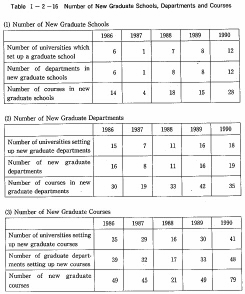
| Back to Top | MEXT HOME |